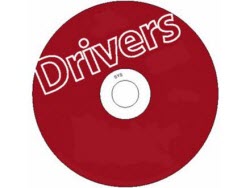A device driver (commonly referred to as simply a driver) is a computer program that operates or controls a particular type of device that is attached to a computer. A driver provides a software interface to hardware devices, enabling operating systems and other computer programs to access hardware functions without needing to know precise details of the hardware being used. ~ <Wikipedia>
When it comes to drivers I have always adhered to the ‘if it ain’t broke, it doesn’t need fixing’ philosophy. Provided everything is working fine from the outset and nothing changes from when you first connect your new device and install the driver, what’s the point in updating and taking the risk of maybe breaking something? Of course, there are exceptions to the rule, and I’ll expand on that as we go along.
The Difference Between Microsoft Drivers & Manufacturer Drivers
 The default drivers provided by Microsoft are actually written by the manufacturer but are stripped down and often older versions. The biggest difference then with manufacturer drivers is that they more often than not include additional software packaging, such as a control panel or status monitor.
The default drivers provided by Microsoft are actually written by the manufacturer but are stripped down and often older versions. The biggest difference then with manufacturer drivers is that they more often than not include additional software packaging, such as a control panel or status monitor.
The driver packages Windows automatically installs are the core drivers created by the device manufacturer and provided by Microsoft after passing through Microsoft’s WHQL (Windows Hardware Quality Labs) to ensure they’re stable. They include just the basic software required to get your device up and running.
On the other hand, drivers obtained through the device manufacturer will more often than not include a software package that expands the feature set and enables more settings and options; examples are graphics card control panels, and a printer’s status monitor.
Another example is the plain old mouse; plug in a new mouse and Windows will automatically install a generic driver to get the mouse up and working for you but, if you want access to more bells and whistles, such as a battery level meter or to customize button functions, you’ll need the additional software package provided by the manufacturer.
Why/When are Drivers Updated

In most cases, updates to hardware drivers are not security related and often involve an upgrade of the software packaging rather than the actual driver. Another reason drivers might be updated is to add support for newly released hardware, technology, or operating systems. Again, if your driver works fine from the outset and nothing has changed, you generally do NOT need to update the driver.
The exception to the rule is, of course, for those individuals who tend to utilize the additional settings and options provided by the manufacturer’s bundled software package. Even then, I would suggest checking through the change-log, if available, to see if the new version adds anything of importance before jumping in.
There are other exceptions too; gaming enthusiasts, for example, would more than likely want to keep their graphics card driver updated to help keep up with performance enhancements. Plus, of course, when a device is not working or is presenting the user with issues. However, as a general rule, when it comes to drivers, I would suggest that leaving well enough alone is more often than not the advisable policy.
Remember folks, the XP era is dead and gone. Hardware support has improved dramatically in the modern Windows operating system:
- In many cases, installing a manufacturer’s device driver is not necessary
- Updating a driver may not necessarily improve anything but has the potential to actually break something.
- And using older versions of device drivers is generally not going to hurt anything (with the possible exception of graphics drivers)
Driver Update Software
A special mention for driver update programs… don’t use them! You’ve more than likely come across these types of products at some time, with generic names such as Driver Genius, Driver Detective, Driver Checker, etc. If you are running a modern operating system, they are, in my humble opinion, not necessary and will often create more problems than they could possibly fix.
Many of these types of utilities are published by people who don’t give one iota about updating drivers, and some of them are disguised malware, pure and simple. Caveat Emptor.

Good, reasoned explanation. Thanks Jim!
I do not whole heartedly agree with your statement to stay away from driver update software as I have had just as many heartaches installing drivers through Windows Update as I have had using driver update software. Matter of fact drivers I have updated through Windows Update have crashed my system more times than I care to think about.
My theory is if you are going to use driver update software, get the software from a reputable company and you will have very minimal of problems, also be smart about what you are updating and do not just willy nilly click on an update and install it, make sure the updated driver is compatible with your system and hardware and follow the install instructions to a tee.
I think you might have missed the whole point of the article. Which is – it doesn’t really make a lot of difference what the source is, there is often no real reason to update divers at all.
Agreed Jim.I’m from the old “if it ain’t broke,don’t fix it” school.MS supplied drivers have served me well since the early days of XP,though I really never found the need to update more than a few.Network (ethernet) drivers come to mind here.I’ve got an old XP rig that runs just fine with the original driver off the supplied disk from Dell.
Regarding manufacturer drivers for items such as video cards,I’m careful to perform custom installations.I’m not a gamer,and I don’t need the extra five running processes (four that want to run at boot) from my dear friends over at Nvidia.
If you REALLY need a driver update,your rig will let you know it.
Cheers!!
Agreed Chuck. Install NVIDIA’s latest driver and add about 4 different processes to Windows startup which do nothing but consume resources… very handy!
Like NVIDIA’s HD audio driver’s that show up under the other’s button in Device Manager. Had to go back and reinstall the HD audio drivers to keep the (found new hardware wizard from running). Daniel.